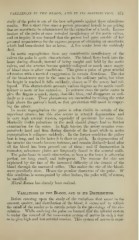Page 661 - My FlipBook
P. 661
VARIATIOyS IX THE BLOOD, AND IN ITS DISTRIBUTION. 671
study of the pulse is one of the best safeguards against these calamitous
results. But a short time since a person presented herself to me asking
that an ansesthetic be administered for the extraction of a tooth. Exam-
ination of the pulse at once revealed insufficiency of the aortic valves,
and on inquiry it was learned that the patient had gone outside of her
personal acquaintance for the express purpose of obtaining an anaesthetic
which had been denied her at home. A few weeks later she suddenly-
died.
In aortic regurgitation from any considerable insufficiency of the
valves the pulse is quite characteristic. The blood flows back into the
heart during diastole, instead of being caught and held by the aortic
valves, and the arteries become quickly collapsed or much more empty
of blood than in other conditions. This gives a pulse of great arterial
relaxation with a marked exaggeration in certain directions. The rise
of the blood-wave may be the same as in the ordinary pulse, but when
the height is reached it falls suddenly, almost as if the artery had col-
lapsed. This characteristic presents various degrees as the aortic insuf-
ficiency is more or less extensive. In extreme cases the pulse seems to
give the fingers a quick, sharp, shot-like blow, and disappears as sud-
denly as it came. These phenomena are intensified by raising the w'rist
high above the patient's head, so that gravitation will assist in empty-
ing the artery.
In aoitic regurgitation the pulse is often visible in certain of the
superficial arteries, but this also occurs in arterial degeneration and
in very high arterial tension, especially if persistent tor some time.
Markedly visible pulsations in the neck should always lead to further
examination for the cause. In high tension the artery remains com-
paratively hard and firm during diastole of the heart, while in aortic
regurgitation it collapses suddenly. In the former condition the pulse-
beat is long, and in the latter it is short or quick. In degeneration of
the arteries the vessels become tortuous, and remain distinctly hard after
all the blood has been pressed out of them ; and if degeneration is
extensive, calcareous plates are frequently found in the arterial walls.
The pulse-beats in aortic obstrucfion, so long as the heart is otherwise
perfect, are long, small, and infrequent. The reasons for this are
explained by the fact of the increased difficulty of the transit of the
blood through the narrowed orifice. This makes the rise of the blood-
wave peculiarly slow. Hence the peculiar characters of the pulse. If
this condition is accompanied by other lesions, the pulse wall, of course,
be modified.
Mitral disease has already been noticed.
Variations in the Blood, and in its Distribution.
Before entering upon the study of the variations that occur in the
amount, quality, and distribution of the blood, it seems well to refresh
the mind of the reader as to certain points in the physiology of the cir-
culation. While studying the pulse we learned that the arterial system
is under the control of the vaso-motor system of nerves in such a way
as to give high and low arterial tension. This system of nerves is capa-


